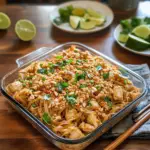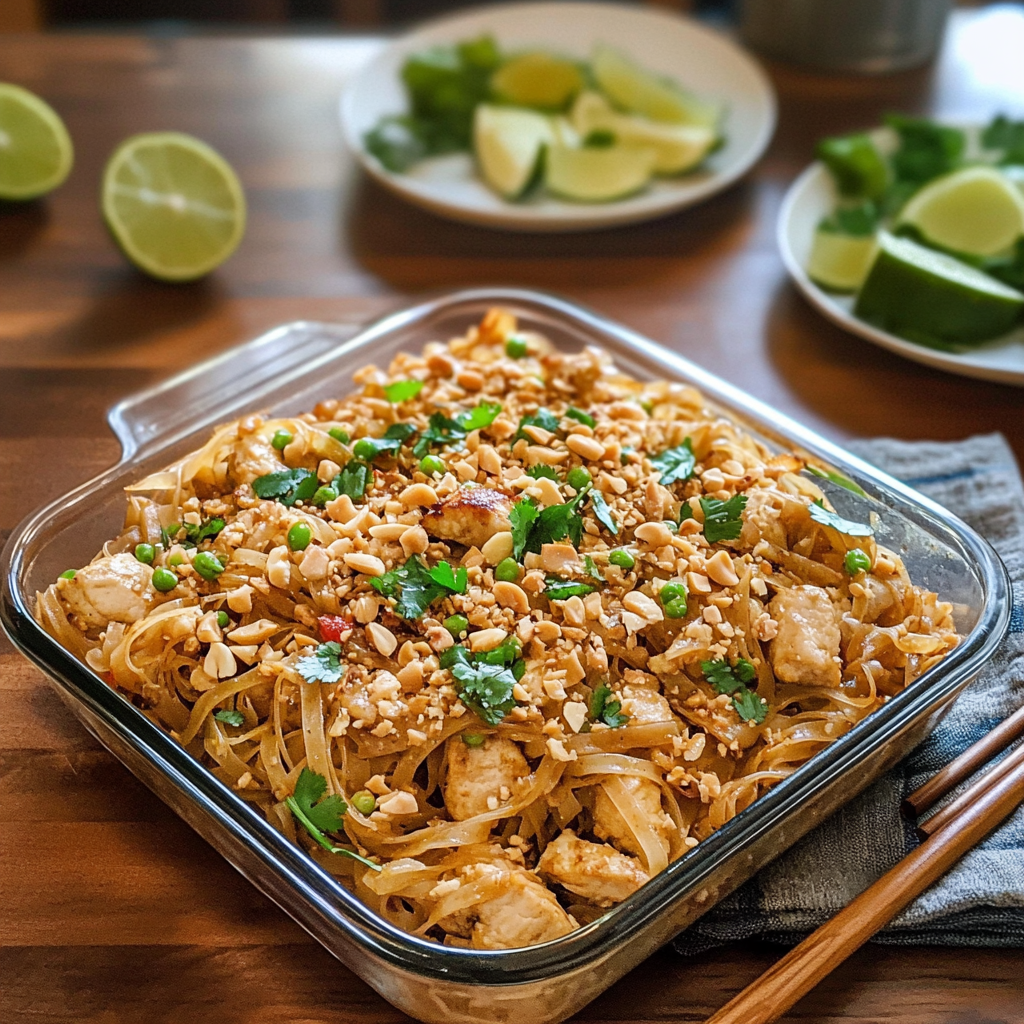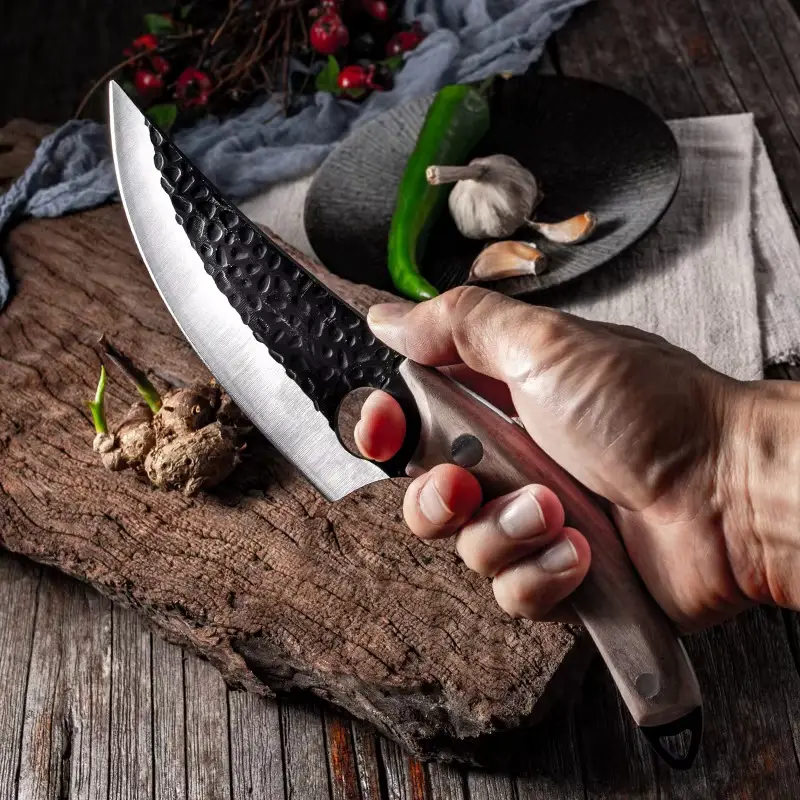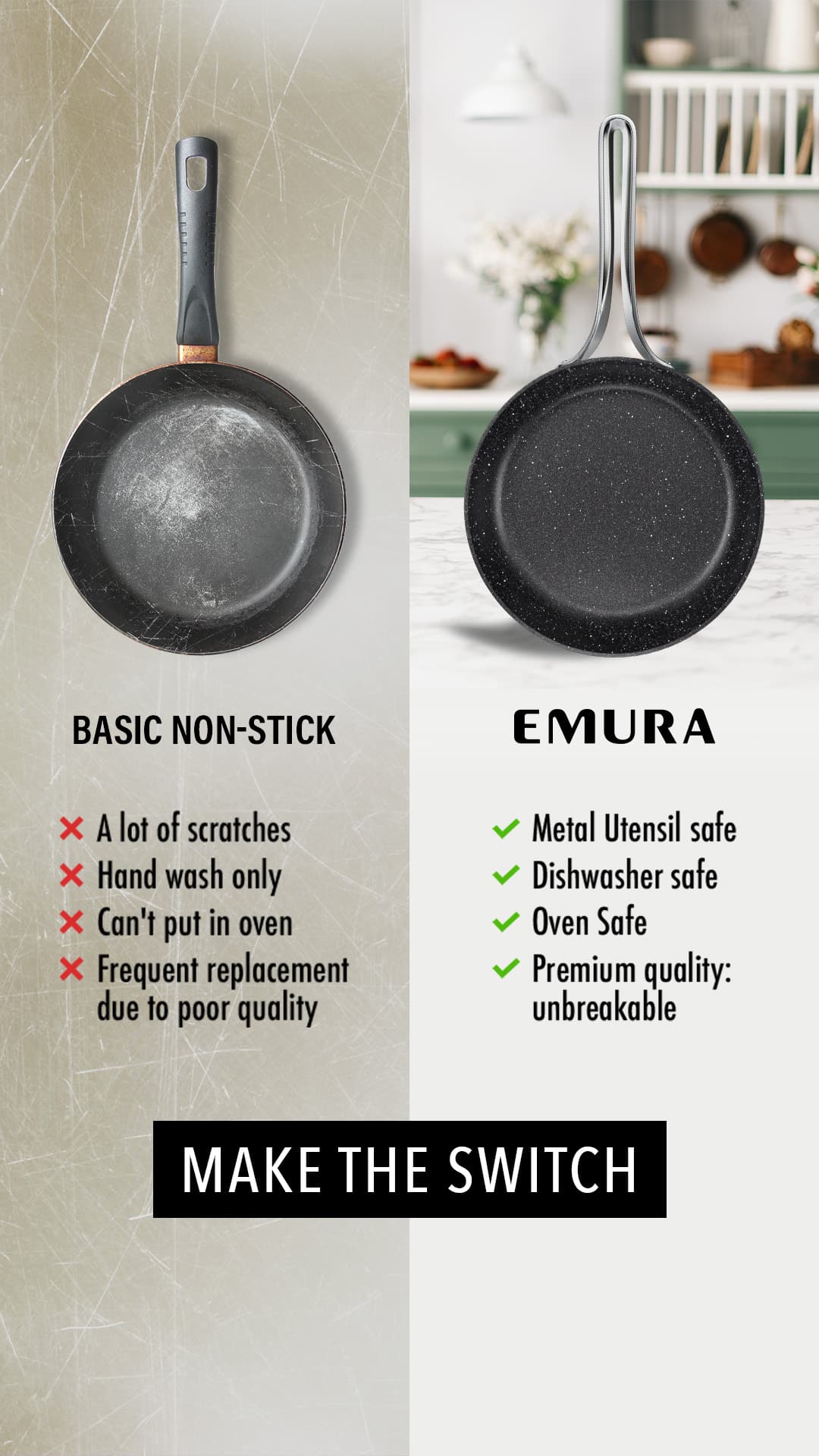Chicken Pad Thai is one of the most beloved Thai dishes around the world, featuring a harmonious balance of sweet, sour, salty, and umami flavors. This stir-fried noodle dish is packed with tender chicken, chewy rice noodles, crunchy peanuts, and fresh vegetables, all tossed in a tangy tamarind-based sauce. It’s a true comfort food that satisfies your cravings for something hearty, flavorful, and slightly exotic.
Pad Thai, often referred to as Thailand’s national dish, originated as a way to promote the use of rice noodles during a time when Thailand was aiming to reduce its rice exports. Over time, it evolved into a street food staple and a global favorite. Traditionally, Pad Thai includes shrimp, but in this variation, we’ll focus on chicken to make it a protein-packed dish that’s easy to prepare at home.
In this recipe, you’ll learn how to make Chicken Pad Thai that rivals your favorite takeout spot. With step-by-step instructions, ingredient tips, and plenty of variations, you’ll master the art of this delicious dish in no time.
Why You’ll Love This Recipe
- Authentic Flavors: Combines traditional ingredients like tamarind, fish sauce, and palm sugar for an authentic taste.
- Quick and Easy: Ready in just 30 minutes, making it perfect for weeknight dinners.
- Customizable: Adjust the spice level, swap out proteins, or add extra veggies to make it your own.
- Healthy Option: Packed with lean chicken, fresh ingredients, and gluten-free rice noodles.
- A Crowd-Pleaser: Whether for a family dinner or a casual get-together, everyone will love this flavorful dish.
- Restaurant Quality at Home: With the right techniques and ingredients, you can recreate this Thai classic without leaving your kitchen.
Preparation Time and Servings
- Prep Time: 15 minutes
- Cook Time: 15 minutes
- Total Time: 30 minutes
- Yield: 4 servings
- Serving Size: 1 bowl
Nutritional Information (per serving)
- Calories: 450
- Carbohydrates: 55g
- Protein: 30g
- Fat: 12g
- Fiber: 4g
- Sugar: 8g
Ingredients
For the Pad Thai Sauce:
- 2 tablespoons tamarind paste (or tamarind concentrate)
- 3 tablespoons fish sauce (or soy sauce for a vegetarian option)
- 2 tablespoons palm sugar (or brown sugar)
- 1 tablespoon rice vinegar (optional, for extra tang)
- 1–2 teaspoons Sriracha or chili paste (optional, for spice)
For the Noodles:
- 8 ounces (250g) flat rice noodles
- Hot water (to soak the noodles)
For the Chicken and Stir-Fry:
- 2 tablespoons vegetable oil (or peanut oil)
- 1 pound (450g) boneless, skinless chicken breasts or thighs, thinly sliced
- 3 garlic cloves, minced
- 2 large eggs, lightly beaten
- 1 cup bean sprouts
- ½ cup shredded carrots (optional)
- 2 green onions, sliced diagonally
- ¼ cup chopped peanuts (for topping)
For Garnish:
- Lime wedges
- Fresh cilantro leaves
- Extra peanuts for topping
- Red pepper flakes (optional)
Step-by-Step Instructions
Step 1: Prepare the Pad Thai Sauce
- In a small bowl, combine tamarind paste, fish sauce, palm sugar, rice vinegar, and Sriracha.
- Stir well until the sugar is dissolved. Taste the sauce and adjust the balance of sweet, salty, and sour flavors according to your preference. Set aside.
Step 2: Soak the Rice Noodles
- Place the rice noodles in a large bowl and pour hot water over them, ensuring they are fully submerged.
- Let the noodles soak for 6–8 minutes, or until they are softened but still slightly firm (al dente). Drain and set aside.
Step 3: Cook the Chicken
- Heat 1 tablespoon of vegetable oil in a large wok or skillet over medium-high heat.
- Add the sliced chicken and stir-fry for 5–6 minutes, or until fully cooked and golden brown. Remove the chicken from the wok and set aside.
Step 4: Cook the Eggs
- In the same wok, add another tablespoon of oil.
- Push the oil to one side and pour in the beaten eggs. Scramble the eggs gently until they are just set, then mix them into the rest of the pan.
Step 5: Stir-Fry the Noodles
- Add the soaked and drained rice noodles to the wok, along with the cooked chicken.
- Pour the Pad Thai sauce over the noodles and toss well to coat evenly.
- Stir-fry for 2–3 minutes, until the noodles are tender and the sauce is absorbed.
Step 6: Add Vegetables
- Add the bean sprouts, shredded carrots (if using), and half of the green onions.
- Stir-fry for 1–2 minutes, just until the vegetables are slightly wilted but still crunchy.
Step 7: Garnish and Serve
- Divide the Chicken Pad Thai into bowls or plates.
- Top with chopped peanuts, the remaining green onions, and fresh cilantro.
- Serve with lime wedges on the side and sprinkle with red pepper flakes for extra heat. Enjoy immediately!
Ingredient Background
- Tamarind Paste: This sour, tangy ingredient is essential for authentic Pad Thai sauce. You can find it in Asian grocery stores or online.
- Fish Sauce: A salty, umami-packed liquid made from fermented fish. Soy sauce can be used as a substitute for vegetarians or those who prefer a milder flavor.
- Palm Sugar: Adds sweetness and depth to the sauce. Brown sugar works as a convenient alternative.
- Rice Noodles: Flat rice noodles are traditional for Pad Thai, as they soak up the sauce beautifully and have a chewy texture.
- Bean Sprouts: Provide a fresh, crunchy contrast to the soft noodles.
- Peanuts: Add a nutty flavor and a satisfying crunch.
Technique Tips
- Soak, Don’t Boil: Rice noodles should be soaked in hot water until just softened. Boiling can make them mushy.
- Work Quickly: Pad Thai comes together fast, so have all your ingredients prepped and ready to go before you start cooking.
- Use a Wok: A wok is ideal for stir-frying because it heats evenly and allows you to toss the ingredients easily.
- Adjust Sauce to Taste: Taste the sauce before adding it to the wok and adjust the sweetness, saltiness, or tanginess to your liking.
- Don’t Overcrowd the Pan: If you’re doubling the recipe, cook the chicken and noodles in batches to ensure even cooking.
Alternative Presentation Ideas
- Vegetarian Pad Thai: Replace chicken with tofu or extra vegetables like broccoli, bell peppers, or snap peas. Use soy sauce instead of fish sauce.
- Seafood Pad Thai: Swap chicken for shrimp, scallops, or a mix of seafood for a coastal twist.
- Peanut-Free Pad Thai: Use sesame seeds or sunflower seeds for garnish instead of peanuts.
- Zoodle Pad Thai: Replace rice noodles with spiralized zucchini for a low-carb version.
- Spicy Pad Thai: Add extra chili paste, fresh chili slices, or chili oil for a fiery kick.
Additional Tips for Success
- Prep Ahead: Chop the vegetables, mix the sauce, and soak the noodles ahead of time to streamline the cooking process.
- Heat Control: Cook on medium-high heat to achieve the right level of char and caramelization.
- Customize Protein: Use pork, beef, or even leftover rotisserie chicken if you don’t have fresh chicken on hand.
- Serve Immediately: Pad Thai is best enjoyed fresh. The noodles can become gummy if left to sit too long.
Recipe Variations
- Egg-Free Pad Thai: Omit the eggs for a vegan-friendly version.
- Thai Basil Pad Thai: Stir in fresh Thai basil leaves at the end for an herbal twist.
- Sweet and Sour Pad Thai: Add pineapple chunks for a sweet and tangy flavor profile.
- Extra Crunchy Pad Thai: Top with fried shallots or crispy fried garlic for added texture.
Freezing and Storage
- Refrigerator: Store leftovers in an airtight container in the fridge for up to 3 days. Reheat gently in a skillet or microwave, adding a splash of water to loosen the sauce if needed.
- Freezer: Pad Thai is best enjoyed fresh, but you can freeze portions for up to 2 months. Thaw overnight in the fridge before reheating.
Healthier Twist Ideas
- Lower the Carbs: Use zucchini noodles, spaghetti squash, or shirataki noodles instead of rice noodles.
- Reduce the Sugar: Cut the sugar in half or use a natural sweetener like stevia.
- Add More Veggies: Double the amount of bean sprouts and carrots, or add spinach, kale, or mushrooms for extra nutrients.
- Lighten the Sauce: Use low-sodium soy sauce and skip the rice vinegar for a lighter version.
Serving Suggestions for Events
- Casual Weeknight Dinner: Pair Chicken Pad Thai with a Thai cucumber salad for a refreshing side.
- Dinner Party: Serve as part of a Thai-inspired menu alongside spring rolls, green curry, and mango sticky rice.
- Meal Prep: Divide into containers for quick and flavorful lunches throughout the week.
- Potluck Dish: Bring a large batch of Pad Thai to your next potluck—it’s a guaranteed crowd-pleaser.
Special Equipment
- Wok or Large Skillet: A wok ensures even heat distribution and allows for easy tossing.
- Tongs or Spatula: Essential for tossing the noodles and mixing the ingredients.
- Sharp Knife: For slicing the chicken and vegetables evenly.
Frequently Asked Questions
- Can I use tamarind concentrate instead of paste?
Yes! Use tamarind concentrate, but reduce the amount since it’s more potent than paste. - What if I can’t find fish sauce?
Substitute with soy sauce or coconut aminos for a similar salty, umami flavor. - Why are my noodles sticky?
Make sure to soak the noodles until just tender and toss them with oil before cooking to prevent sticking. - Can I make Pad Thai gluten-free?
Yes, use gluten-free rice noodles and tamari or coconut aminos instead of soy sauce. - What’s the best way to reheat leftovers?
Reheat Pad Thai in a skillet over medium heat, adding a splash of water to loosen the sauce. - Is Pad Thai spicy?
It can be mildly spicy or not spicy at all, depending on how much chili paste or Sriracha you use. - Can I double the recipe?
Yes, but cook the chicken and noodles in batches to avoid overcrowding the pan. - Can I make Pad Thai vegan?
Yes! Use tofu instead of chicken, soy sauce instead of fish sauce, and skip the eggs.
Conclusion
Chicken Pad Thai is a vibrant and flavorful dish that brings the taste of Thailand into your home. With its perfectly balanced sauce, tender chicken, chewy noodles, and crunchy toppings, it’s no wonder this dish is a global favorite. Whether you’re making it for a quick weeknight meal or a special occasion, this recipe is guaranteed to impress. Try it today and enjoy the rich, authentic flavors of Chicken Pad Thai from the comfort of your own kitchen!
Print
Chicken Pad Thai
- Total Time: 30 minutes
- Yield: 4 servings 1x
Ingredients
For the Pad Thai Sauce:
- 2 tablespoons tamarind paste (or tamarind concentrate)
- 3 tablespoons fish sauce (or soy sauce for a vegetarian option)
- 2 tablespoons palm sugar (or brown sugar)
- 1 tablespoon rice vinegar (optional, for extra tang)
- 1–2 teaspoons Sriracha or chili paste (optional, for spice)
For the Noodles:
- 8 ounces (250g) flat rice noodles
- Hot water (to soak the noodles)
For the Chicken and Stir-Fry:
- 2 tablespoons vegetable oil (or peanut oil)
- 1 pound (450g) boneless, skinless chicken breasts or thighs, thinly sliced
- 3 garlic cloves, minced
- 2 large eggs, lightly beaten
- 1 cup bean sprouts
- ½ cup shredded carrots (optional)
- 2 green onions, sliced diagonally
- ¼ cup chopped peanuts (for topping)
For Garnish:
- Lime wedges
- Fresh cilantro leaves
- Extra peanuts for topping
- Red pepper flakes (optional)
Instructions
Step 1: Prepare the Pad Thai Sauce
- In a small bowl, combine tamarind paste, fish sauce, palm sugar, rice vinegar, and Sriracha.
- Stir well until the sugar is dissolved. Taste the sauce and adjust the balance of sweet, salty, and sour flavors according to your preference. Set aside.
Step 2: Soak the Rice Noodles
- Place the rice noodles in a large bowl and pour hot water over them, ensuring they are fully submerged.
- Let the noodles soak for 6–8 minutes, or until they are softened but still slightly firm (al dente). Drain and set aside.
Step 3: Cook the Chicken
- Heat 1 tablespoon of vegetable oil in a large wok or skillet over medium-high heat.
- Add the sliced chicken and stir-fry for 5–6 minutes, or until fully cooked and golden brown. Remove the chicken from the wok and set aside.
Step 4: Cook the Eggs
- In the same wok, add another tablespoon of oil.
- Push the oil to one side and pour in the beaten eggs. Scramble the eggs gently until they are just set, then mix them into the rest of the pan.
Step 5: Stir-Fry the Noodles
- Add the soaked and drained rice noodles to the wok, along with the cooked chicken.
- Pour the Pad Thai sauce over the noodles and toss well to coat evenly.
- Stir-fry for 2–3 minutes, until the noodles are tender and the sauce is absorbed.
Step 6: Add Vegetables
- Add the bean sprouts, shredded carrots (if using), and half of the green onions.
- Stir-fry for 1–2 minutes, just until the vegetables are slightly wilted but still crunchy.
Step 7: Garnish and Serve
- Divide the Chicken Pad Thai into bowls or plates.
- Top with chopped peanuts, the remaining green onions, and fresh cilantro.
- Serve with lime wedges on the side and sprinkle with red pepper flakes for extra heat. Enjoy immediately!
- Prep Time: 15 minutes
- Cook Time: 15 minutes
Nutrition
- Serving Size: 1 bowl
- Calories: 450
- Sugar: 8g
- Fat: 12g
- Carbohydrates: 55g
- Fiber: 4g
- Protein: 30g



